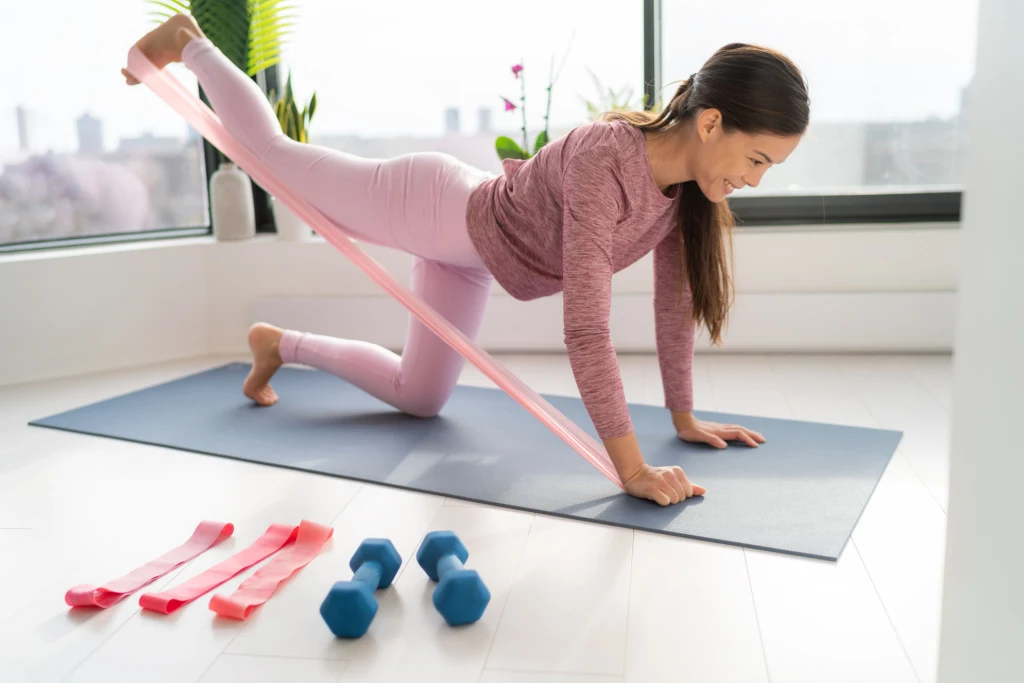The Best Home Gym Equipment For At-Home Workouts

April 3, 2020 - Updated January 3, 2024

Whether you want to level up your at-home Sweat sessions or you’ve decided to start working out at home, you might be wondering what kind of equipment you should be investing in. While there are plenty of zero-equipment training options in the Sweat app, there are also some simple items that can help you to enjoy a greater variety of exercises and make others more challenging.
Not sure where to start? We’ve put together a comprehensive list of the best home gym equipment. And if you don’t want to invest in equipment, that’s okay too! There are plenty of household items (and members… more on that later!) you can use instead.
Best home gym equipment
We love small, staple pieces of equipment that allow you to do a variety of different exercises without breaking the bank or taking up too much space. Some home gym equipment is perfect for strength training, while other pieces are better for at-home cardio.
If you want to learn how to create your own home gym, knowing which equipment to invest in first is a useful starting point. The Sweat Community also has plenty of advice when it comes to taking your at-home workouts to the next level!

Equipment for strength training at home
These items allow you to make exercises more challenging by adding resistance.
Resistance bands
Resistance bands add variable resistance to strength exercises, helping with muscle activation while increasing the intensity of the movement.
Try wrapping a resistance band around your quads when you do bodyweight squats, walking side-to-side in a lateral band walk, or for some variable resistance for a spicy arm workout.
There are so many resistance band exercises you can do at home to strengthen your full body, and they often feature in Pilates workouts too!
Ankle or wrist weights
Ankle and wrist weights are a great addition to your at-home set up. Whether you’re looking to challenge yourself in lower or upper body workouts (or both!) they will add weight and resistance in any movements you do. This makes movements more challenging without having to hold weights in your hands.
The best part about ankle weights is the convenience: they’re portable and can be attached to your ankles for high-intensity cardio, strength training, Pilates, high-intensity resistance training or even to make a walk more challenging. They can also be a great starting point if you’ve never added weights to your workouts before. Try this ankle weight routine you can do from anywhere to get started.
Dumbbells
These are a classic staple of any home gym. They don’t take up a lot of space and can be added to almost any exercise to increase the intensity and resistance, making them a versatile and worthwhile investment.
It’s recommended you start with three different weight variations (or an adjustable set) so you have a few to choose from. It’s normal to find you can lift heavier weights for leg exercises than you do for upper body movements as the muscles in your lower body are usually larger and stronger.
Bench
If you have the space, a bench could be a great investment for your home gym. A bench will allow you to do upper-body strength training with dumbbells (think: dumbbell bench press and tricep dips), lower-body movements such as dumbbell step ups, or cardio exercises including bench hops.
Kettlebell
This free weight has a large round bottom with a handle on top. Kettlebells are great for heavier strength training like goblet squats, single-arm kettlebell swings and kettlebell deadlifts. We recommend you go for a heavier kettlebell weight than you would choose for dumbbells as you'll generally only use one kettlebell at a time and the movements typically focus on your lower body.
Fitball
A fitball is a great investment for your home gym, particularly when it comes to core exercises or if you’re a Pilates lover. Fitballs take up a fair bit of space, but are a useful tool that will give you a variety of new exercises to do at home. Some fitball exercises include sit-ups & twists, glute bridge & hamstring curls, swiss ball roll ins, exercise ball crunches, and ball leg curls. Fitballs are great for targeted core activation exercises like these.

Equipment for cardio at home
Home gym equipment isn’t just for strength training. These key pieces will help you take your cardio sessions to the next level.
Fitness mat
A mat is arguably the most useful piece of equipment to have at home. You can use this for recovery stretching, as a soft support for your joints when doing cardio exercises on hard surfaces, and in your strength training sessions.
When buying your mat, there are several different types to choose from so think about what training styles you’ll be using the mat for before purchasing. Yoga mats are usually thin, while exercise or Pilates mats are often thicker for added support. If you’re looking for a product that will see you through recovery stretches and high-intensity workouts (or you’re trying to muffle the noise for your neighbours), we’d recommend investing in a thicker mat to cover all your bases!
Jump rope
A jump rope is a great addition to your home workout kit - and a great piece to take on the road with you. Skipping with a jump rope will quickly get your heart rate up and you can use it to warm up or as part of a HIIT workout.
Sliders
If you have floorboards, tile, or linoleum floors, sliders are worth investing in. Use these as part of your cardio routine or if you want to make core exercises more challenging. We love using them in mountain climbers: place your feet on the sliders in a plank position, and alternate bringing your feet up to your chest, sliding your feet along the floor.
While not an essential item, sliders are great for making cardio exercises a little bit more challenging for your core.
Bosu ball
A bosu ball is like “half” of a fitball, with a flat plastic edge along one side and can be used for cardio and core exercises. You’ll find them in exercises such as a bosu ball mountain climber and side-to-side bosu shuffle, but you can also use them to increase the difficulty of movements like a plank, simply place your feet on the flat plastic side while you’re in plank position. Adding a bosu ball to a burpee can add a whole new challenge by testing your stability!

Equipment for recovery at home
Having a few key pieces of equipment is about more than your actual workout.
Foam roller
A foam roller is a great recovery tool to have on hand. The benefits of foam rolling include everything from improving your flexibility to encouraging muscle recovery.
Use a foam roller after your workout to stretch out your muscles and reduce tension and soreness. Depending on the size, foam rollers are usually light, portable and small, so you can also take them away with you as they don’t take up too much space.
Trigger point ball
Another at-home recovery tool is a trigger point ball, which is another self-massage tool like a foam roller and allows you to target sore muscles and joints to loosen and relax them.
Substitutes using common household items
While home gym equipment is awesome, you do not need to invest in gym equipment to get the most out of your fitness program. There are many useful alternatives you will likely already have around the house. Some Sweat Community favourites include brooms for stick stretches, small children for weighted squats or glute bridges, and bottles instead of dumbbells!
Chair
Don’t want to invest in a bench? Use a sturdy chair instead. While it won’t be as versatile because you can’t lie down on it, you can still use a chair for a number of movements such as step-ups, tricep dips, or bench jump overs.
If you’re using a chair, you’ll need to make sure it’s strong enough to hold your weight to prevent injury, or have it up against a wall so it can’t slip backwards. Alternatively, you could use a step or ledge if you have one around.
Plastic bottles
Plastic bottles can be used instead of dumbbells or kettlebells. Have a look around your house for empty water bottles, shampoo bottles, or detergent bottles. Simply fill these up with water and use them as added weights to your strength training routine! You can also fill the bottles with dirt or sand to create heavier weights.
Wall
While you may not realise it, an empty wall is a useful piece of gym equipment. You can use a wall to do wall-sits, where you sit with your back against the wall and your legs in front of you at a 90-degree angle, working your quads and core.
Alternatively, you can use your wall to do handstands for upper-body strength training. Simply place your hands on the floor with your fingers pointing away from the wall, and walk your feet up the wall. If you’re in a garage or exercising outside, a wall makes it easier to complete high-intensity exercises like wall balls, too!
Towel
If you don’t have resistance bands, you can use a towel in some exercises, such as band pull-aparts. Instead of your resistance band, hold the towel out in front of you and pull from either end. This can also be done above your head as a shoulder exercise. If you’re doing Pilates workouts, a rolled up towel can be a great replacement for a Pilates ball, too.
Pillows
If you don’t have a bench, use a pillow to do a dumbbell bench press by lying down on top of the pillow on the floor. You can also use a pillow to create a slight incline for crunches.
Staircase
If you have stairs at home, this is the perfect tool for at-home cardio with no extra equipment. You can run up and down your stairs as a simple cardio warm-up, or add step-ups into your cardio workouts as an individual exercise.
Exercising at home without equipment
While gym equipment is useful to have for working out at home, it’s not necessary. Working out at home is convenient, inexpensive and just as effective with or without equipment. There are a number of no-equipment programs in the Sweat app such as PWR Zero, FIERCE Zero Equipment and High Intensity Zero Equipment.

A more empowered you starts with Sweat, and our editorial team is here to bring you the latest fitness tips, trainer recommendations, wellbeing news, nutritional advice, nourishing recipes and free workouts.
* Disclaimer: This blog post is not intended to replace the advice of a medical professional. The above information should not be used to diagnose, treat, or prevent any disease or medical condition. Please consult your doctor before making any changes to your diet, sleep methods, daily activity, or fitness routine. Sweat assumes no responsibility for any personal injury or damage sustained by any recommendations, opinions, or advice given in this article.
Fitness